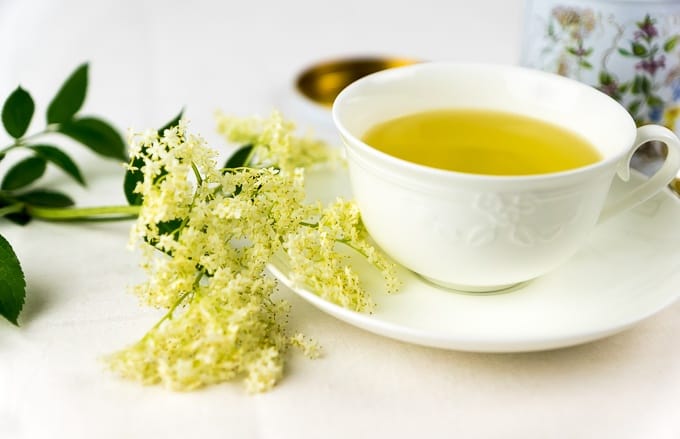
The merry month of May is delighting us with a burst of colors – be it the countless shades of green or the charming colors of blooming trees and flowers. And perfumes, oh, all the lovely scents when passing by lilac trees, honeysuckle, roses, mock orange blossoms, and elderberry blooms. I love them all, but am particularly in love with those wild flowers that are edible. Like lilacs and elderberries. Right now in Germany the lilac season just ended, but I don’t have time to be sad as the elderberry bushes are in full bloom, so the happy harvesting and indulging in sweet, heady scents continues.
To me elderflowers are very familiar as no spring went by in my Romanian childhood without sipping on the delicious “suc de soc” (Romanian elderberry lemonade). Sweet, yummy drinks are exactly what elderflowers are mainly known for, such as cordials, lemonades, syrups, and the Hugo cocktail. It is a shame, though, that elderflower tea is not as popular (yet), since this herbal tea is highly beneficial. Besides, it is floral, delicious, and velvety.
Just read on to find out about the various health benefits and some tips and tricks for harvesting and drying the elderflowers, and how to use the blooms for making tea.
Benefits of Elderberry Blossoms Tea
I like drinking elderflower tea in the evenings as it soothes my mind and my stomach. But the tea is actually best known for its antiviral effects, thus fighting off the flu. You might want to give it a try to drink 3-4 for cups a day as soon as you notice the first flu symptoms.
Elderflower tea is also said to:
- Contain high levels of vitamin C, making it a powerful antioxidant
- Strengthen the heart and the immune system
- Support the metabolism
- Calm the stomach (especially when bloated), and soothe stomach cramps
- Purify the blood
- Stimulate kidney activity
Recommendations for Harvesting
- First and foremost: Make sure it is really elderberry flowers you’re picking, and not cow parsley, pyracantha, or cowbane (the latter is poisonous). Elderflowers grow on bushes, not on the ground; their smell is intense, heady, ‚summery‘ and sweet, and their color is cream, not white.
- Best time for picking elderflowers is around noon on a sunny day as the heat heightens their smell and aroma.
- Choose only heads that are opened completely and that are not past their prime (no brown flowers).
- Shake free of dust and insects right after picking. This is particularly important as it’s not recommended to rinse or wash the blooms before use – this would strongly diminish their aroma.
- Avoid picking along the road as the elderflowers might be polluted with petrol fumes.
- Don’t strip one particular bush bare of elderflower heads. Pick instead from different sources. This way the plants can thrive and you can forage elderberries come fall.
- Collect them in a basket or paper bag as the flowers need to breathe. If you’re using a plastic bag, leave it constantly open.
- Use the elderflower heads as soon as possible (they wilt easily and lose their aroma) or dry them.
- Please be aware that some parts of the elderberry bush are poisonous, such as the leaves, the bark and unripe elderberries.
Recommendations for Drying
To preserve the elderflowers beyond their season and to make tea whenever I’m craving it, I like to dry them.
Drying elderflowers couldn’t be easier. Just spread the blooms out on paper or kitchen towels und leave to dry in a warm, dry and shady spot until they are crispy dry. Store them in an airtight container.
How to Make Elderberry Blossom Tea
Here is how to make this beneficial tea using either freshly picked blooms or dried blossoms. The recipe will yield two cups of tea.
In a teapot, steep 4 fresh elderflowers or 2 teaspoons of dried blossoms in boiling hot water for 5 minutes. I recommend placing a lid on the cup as it helps keep the aromas and agents trapped in.

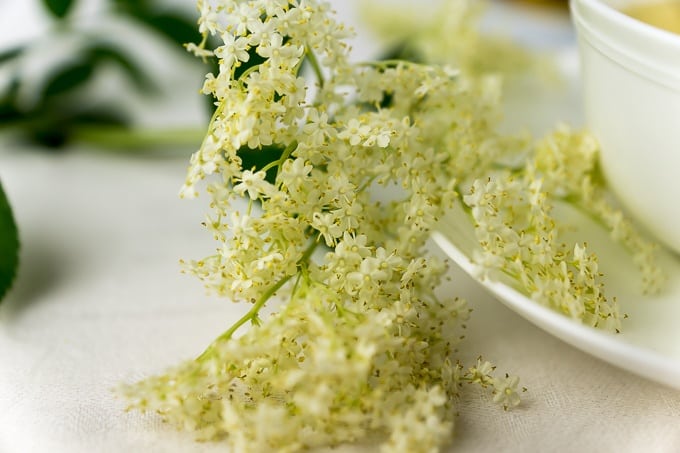

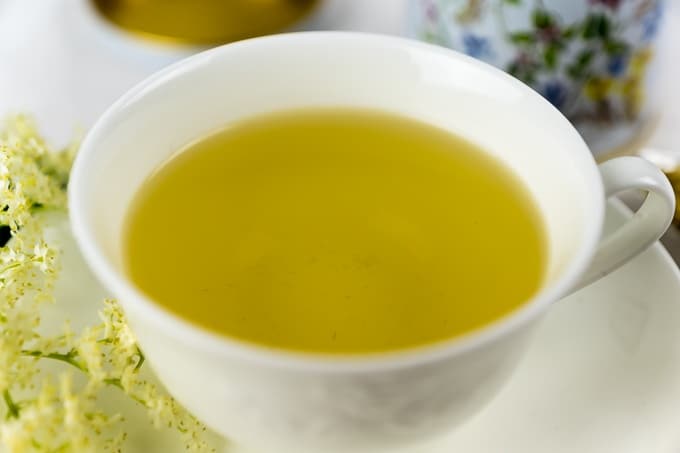

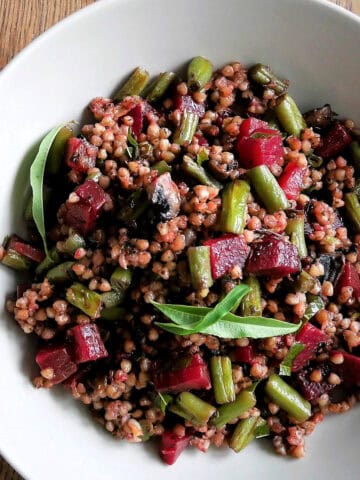

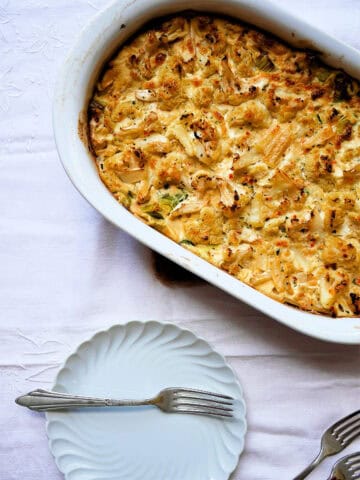
TobyLauren says
Can this be done with red elder as well? I don't have blue elder growing in my area, but we do have red elder. I've heard mixed reviews.
Ramona says
Thanks for bringing up this topic. I'm only familiar with black elder, and read mixed reviews concerning red elder as well. As far as I understand, it's been used similar to black and blue elder, but the red elderflowers can cause digestive discomfort to some people. Unfortunately, I'm not a botanist or herbalist - but you might want to turn to one if you want to play it safe.
Here is more information on red elder:
https://thefatofthelandblog.wordpress.com/tag/red-elderflower/
http://nativeplantspnw.com/red-elderberry-sambucus-racemosa/
Swantje M. Harvey says
Hi! I finally have plenty Elder in my backyard and found a spot again in the area,after my old familiar one had been cleared for construction. Have always just made syrup and some jelly. Just now, I had to decide to cut back some.because my Okra was not getting enough light and decided to see what to do with the blossoms,which are in full bloom.Also, I often see Elders in bloom in the wild in May,but come August when they are ripe,the lots are too overgrown for little old me to risk foraging into.After reading your advice here,I will go there this week and get googobs of them.Since I live in humid Louisiana in a small house with very little sprawl-out surface,would it be okay to use my dehydrators?
Ramona says
Dear Swantje, thanks a lot for your lovely comment, I enjoyed reading about your garden in Louisiana - how gorgeous that you have such an abundance of Elder blooms and Okra (and probably lots of other produce).
As to your question: I've never used a dehydrator before, but my oven on the lowest heat possible for dehydrating fruit (apple slices, apple peal, etc.). This worked out nicely. I can imagine that you can dehydrate blossoms in the same way, be it in the oven or the dehydrator. As blooms and blossoms are more delicate and less "juicy" compared to fruit slices, I think that they will be quicker to dehydrate as fruit slices.
Wishing you lots of fun foraging.
Yasmin Stephens says
1 Elderflower tea is from non native Sambucus nigra? Correct?
2 Question can i make tea from the native sambucus canadensis? Or not?
Ramona says
Dear Yasmin,
Thank you for your questions! For me at least, the black elderberry (Sambucus nigra) is the most readily available variety here in Germany. While I'm not a botanist or herbalist, from what I've read in these sources, the blooms from Sambucus canadensis can be used in similar ways as those from Sambucus nigra:
https://en.wikipedia.org/wiki/Sambucus_canadensis
https://plants.ces.ncsu.edu/plants/sambucus-canadensis
Margaret Henry says
Wow I have so many wild elderflowers this year. Besides drying them what else can I do with them? TY!
Ramona says
Congrats on the elderflower bounty, I can imagine the gorgeous scents.
You could make Romanian sparkly lemonade, elderflower fritters, or elderflower cordial/syrup.